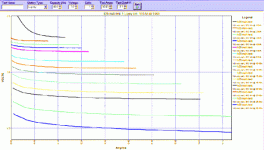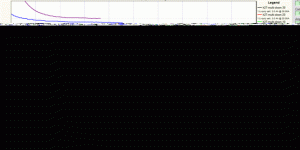RLT
10 kW
OK, this is going to be a little long, and I'll probably provide more details than anyone is interested in (sorry), but here goes, nonetheless:
Tested one battery as ZapPat recommended, but did it with a wider range, starting at 1Amp and increasing in steps up to 30 Amps:

Higher res view here: http://www.az123.com/E-S/h29-multi_1-30A.gif
The battery tested was one of the lower-middle AH ones; 8.60AH at 8A on the first test.
Came off the charger at 3.88V. Let it sit for about 20 minutes, the battery was at 3.83V on the CBA, 3.812V on my good meter, and 3.810V at the Anderson connectors where my clamp type battery holder plugged into the CBA.
I guess the easiest way to give the results is to use the time I did things as the first element:
5:05 PM: Start test at 1A. 30 seconds into the test the CBA indicated 3.48V and the meter indicated 3.493V. The curve started to flatten in about 6 minutes, got quite flat in 10 min.
5:15PM at 1A, CBA indicated 3.31V, Meter indicated 3.307V STOP.
(I let the battery rest between tests long enough that it recovered as much as it was likely to.)
5:35PM Resting battery is 3.35V on CBA, 3.337V on Meter. Start test at 2A: at about 30 seconds, CBA read 3.29V, meter 3.291V.
5:38PM 2@A curve is flat. 3.28V CBA , meter reads 3.280V. STOP
5:45PM resting 3.34V CBA, Meter 3.329V Start 3A test. 30 seconds into test, CBA is at 3.32V, meter is at 3.329.
5:50PM 3A curve is flat, CBA reads 3.24V, meter is 3.356V. STOP
5:55PM resting CBA= 3.34V Meter 3.326V Start 4A test. @30 seconds, CBA=3.22V, Meter=3.240V
5:58PM 4A curve is flat: CBA=3.32V, meter = 3.234V STOP.
]6:05PM Resting CBA=3.34V, meter = 3.326V. Start 5 Amp test. 30 seconds CBA=3.21V, Meter=3.228V
6:08PM 5Amp curve flat: CBA=3.18V, meter=3.210V. STOP
6:18PM Resting CBA=3.34V, Meter=3.326V. Start 8 Amp test. 30 seconds, CBA=3.12V, meter=3.165V
6.21PM 8A curve is flat; CBA=3.10V, Meter=3.145V STOP
6.27PM Resting: CBA=3.34V, Meter=3.323V. Start 10A test. 30 seconds; CBA=3.06v, Meter=3.118V
6:30PM 10A curve is flat, CBA=3.04V, Meter=3.100V. STOP
6:35PM Resting CBA=3.33V Meter= 3.317V Start 12A test. 30 seconds; CBA=3.02V, Meter=3.085V
6:37PM 12A curve is flat, CBA=2.98V, Meter=3.058V STOP.
6:45PM Resting CBA=3.33V, Meter=3.318V. Start 15A test. 30 seconds; CBA=2.93V, Meter=3.017V
6:47PM 15A curve is flat; CBA=2.90V, Meter=3.001V. STOP.
6:55PM Resting CBA=3.32V, Meter=3.306V. Start 18A test. 30 seconds; CBA=2.87V, Meter=2.976V
6.57PM 18A curve is flat; CBA=2.82V, Meter=2.946V. STOP.
7:03PM Resting: CBA=3.31V, Meter=3.296V. Start 20A test. 30 seconds; CBA=2.82V, Meter=2.927V
7:05PM 20A curve is as flat as it is going to get; CBA=2.76V, Meter=2.908V. STOP
7:11PM Resting.: CBA=3.30V, Meter=3.291V. Start 25A test.... CBA immediately self-terminated test.
(So, Ignore that red 25A test entry on the graph)
Seems like even when you click "OK" to override the suggested limitations based on battery type, the CBA won't let you test; That's what got me thinking weeks ago that it was not working properly at higher currents. But I finally figured out that you can trick it, at least for these short term tests. It might not be safe for a long run, but it seems to work fine like this. I increased the entry of the AH capacity of the battery to 40AH, and lowered the cutoff voltage to 2.2V.
So, retrying 25A:
7:20PM Resting: CBA=3.31V, Meter=3.297v. Start 25A test. 30 seconds; CBA=2.69V, Meter=2.835V
7:22PM 25A curve is as flat as it is going to get; CBA=2.61V, Meter=2.88V. STOP.
7:30PM Resting: CBA=3.30V, Meter=3.284V. Start 30A test. 30seconds: CBA= 2.56v, Meter=2.760V.
7:32PM 30A curve is as flat as it is going to get; CBA=2.48V, Meter=2.713V. STOP.
So, at the higher amp tests, it appears that the CBA is registering voltage quite a bit lower than reality. I think that due to the steep discharge curve, it isn't a huge difference in the actual battery capacity, but I'd guess that they are about 0.1 to 0.25 AH better than my CBA has been saying they are.... Anyone have a better estimate on that based on the info I have provided?
I finished the h29 battery off with a straight 8A test. it had 2.91AH @ 8A left after the individual step tests above. Very close to the end, I tested with the meter: CBA = 2.60V, Meter=2.638V
Tested one battery as ZapPat recommended, but did it with a wider range, starting at 1Amp and increasing in steps up to 30 Amps:

Higher res view here: http://www.az123.com/E-S/h29-multi_1-30A.gif
The battery tested was one of the lower-middle AH ones; 8.60AH at 8A on the first test.
Came off the charger at 3.88V. Let it sit for about 20 minutes, the battery was at 3.83V on the CBA, 3.812V on my good meter, and 3.810V at the Anderson connectors where my clamp type battery holder plugged into the CBA.
I guess the easiest way to give the results is to use the time I did things as the first element:
5:05 PM: Start test at 1A. 30 seconds into the test the CBA indicated 3.48V and the meter indicated 3.493V. The curve started to flatten in about 6 minutes, got quite flat in 10 min.
5:15PM at 1A, CBA indicated 3.31V, Meter indicated 3.307V STOP.
(I let the battery rest between tests long enough that it recovered as much as it was likely to.)
5:35PM Resting battery is 3.35V on CBA, 3.337V on Meter. Start test at 2A: at about 30 seconds, CBA read 3.29V, meter 3.291V.
5:38PM 2@A curve is flat. 3.28V CBA , meter reads 3.280V. STOP
5:45PM resting 3.34V CBA, Meter 3.329V Start 3A test. 30 seconds into test, CBA is at 3.32V, meter is at 3.329.
5:50PM 3A curve is flat, CBA reads 3.24V, meter is 3.356V. STOP
5:55PM resting CBA= 3.34V Meter 3.326V Start 4A test. @30 seconds, CBA=3.22V, Meter=3.240V
5:58PM 4A curve is flat: CBA=3.32V, meter = 3.234V STOP.
]6:05PM Resting CBA=3.34V, meter = 3.326V. Start 5 Amp test. 30 seconds CBA=3.21V, Meter=3.228V
6:08PM 5Amp curve flat: CBA=3.18V, meter=3.210V. STOP
6:18PM Resting CBA=3.34V, Meter=3.326V. Start 8 Amp test. 30 seconds, CBA=3.12V, meter=3.165V
6.21PM 8A curve is flat; CBA=3.10V, Meter=3.145V STOP
6.27PM Resting: CBA=3.34V, Meter=3.323V. Start 10A test. 30 seconds; CBA=3.06v, Meter=3.118V
6:30PM 10A curve is flat, CBA=3.04V, Meter=3.100V. STOP
6:35PM Resting CBA=3.33V Meter= 3.317V Start 12A test. 30 seconds; CBA=3.02V, Meter=3.085V
6:37PM 12A curve is flat, CBA=2.98V, Meter=3.058V STOP.
6:45PM Resting CBA=3.33V, Meter=3.318V. Start 15A test. 30 seconds; CBA=2.93V, Meter=3.017V
6:47PM 15A curve is flat; CBA=2.90V, Meter=3.001V. STOP.
6:55PM Resting CBA=3.32V, Meter=3.306V. Start 18A test. 30 seconds; CBA=2.87V, Meter=2.976V
6.57PM 18A curve is flat; CBA=2.82V, Meter=2.946V. STOP.
7:03PM Resting: CBA=3.31V, Meter=3.296V. Start 20A test. 30 seconds; CBA=2.82V, Meter=2.927V
7:05PM 20A curve is as flat as it is going to get; CBA=2.76V, Meter=2.908V. STOP
7:11PM Resting.: CBA=3.30V, Meter=3.291V. Start 25A test.... CBA immediately self-terminated test.
(So, Ignore that red 25A test entry on the graph)
Seems like even when you click "OK" to override the suggested limitations based on battery type, the CBA won't let you test; That's what got me thinking weeks ago that it was not working properly at higher currents. But I finally figured out that you can trick it, at least for these short term tests. It might not be safe for a long run, but it seems to work fine like this. I increased the entry of the AH capacity of the battery to 40AH, and lowered the cutoff voltage to 2.2V.
So, retrying 25A:
7:20PM Resting: CBA=3.31V, Meter=3.297v. Start 25A test. 30 seconds; CBA=2.69V, Meter=2.835V
7:22PM 25A curve is as flat as it is going to get; CBA=2.61V, Meter=2.88V. STOP.
7:30PM Resting: CBA=3.30V, Meter=3.284V. Start 30A test. 30seconds: CBA= 2.56v, Meter=2.760V.
7:32PM 30A curve is as flat as it is going to get; CBA=2.48V, Meter=2.713V. STOP.
So, at the higher amp tests, it appears that the CBA is registering voltage quite a bit lower than reality. I think that due to the steep discharge curve, it isn't a huge difference in the actual battery capacity, but I'd guess that they are about 0.1 to 0.25 AH better than my CBA has been saying they are.... Anyone have a better estimate on that based on the info I have provided?
I finished the h29 battery off with a straight 8A test. it had 2.91AH @ 8A left after the individual step tests above. Very close to the end, I tested with the meter: CBA = 2.60V, Meter=2.638V








